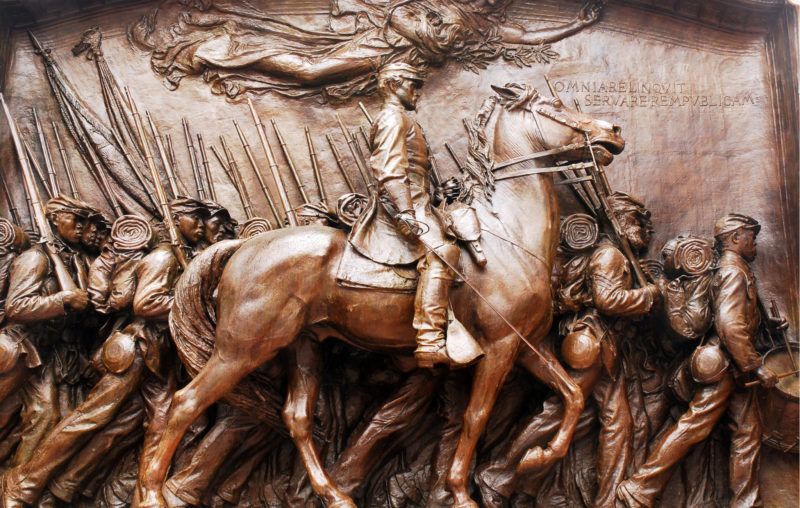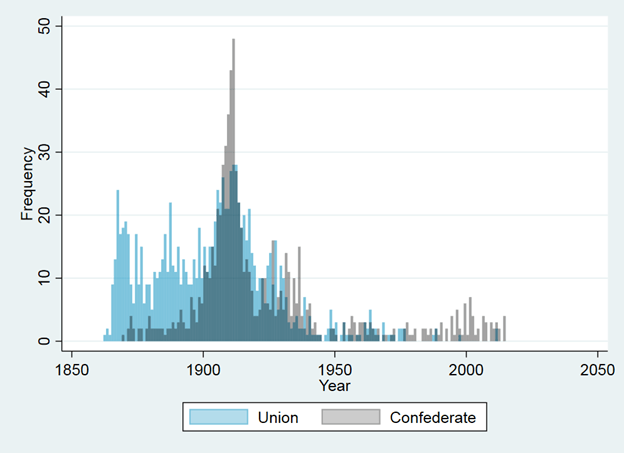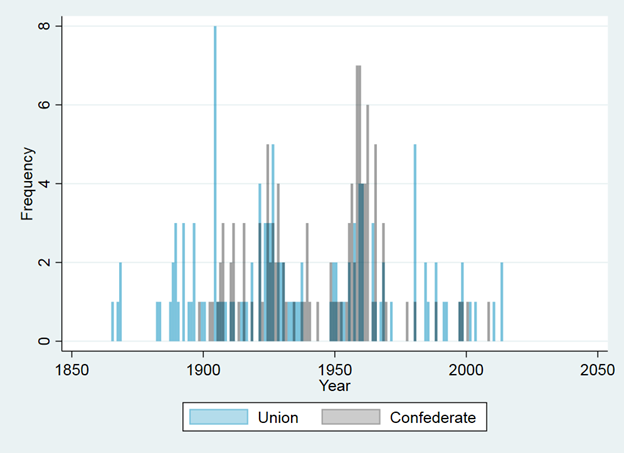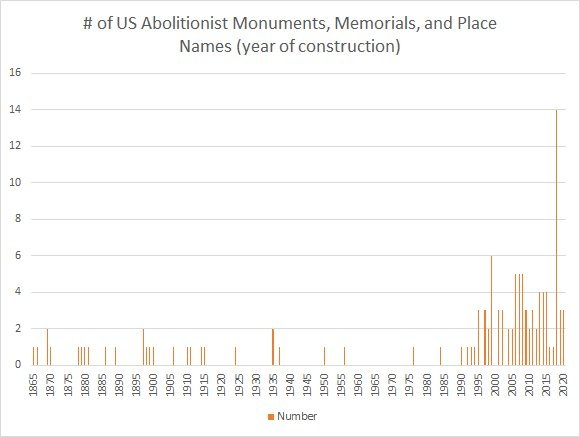What the Data Say About Civil War Monuments

The long-simmering controversy over Confederate symbolism in the Southern United States has boiled over in the wake of anger over police brutality against African-Americans, obliterating any notion that overcoming America’s tragic past of slavery and segregation is no longer relevant today. Longstanding calls on government officials to remove statues associated with pro-slavery figures have given way to protest-fueled iconoclasm–statues and monuments once protested are now defaced and toppled in convulsive anger.
In the immediate wake of this anger lies a fork in the road. Many purporting to speak in the name of fighting racism present the monument controversy as a cut and dry issue. The dead end of mutual recrimination to which this choice leads is already clear. Applauding mob violence leads to indiscriminate attacks increasingly dissociated with any historical context.
The wave of mass vandalism quickly spreads to whatever statue happens to be next in line–targets have already included such figures as George Washington, Thomas Jefferson, Christopher Columbus, Theodore Roosevelt, Miguel de Cervantes, and Winston Churchill. With no small irony, these new targets include figures that several leading historians and journalistic outlets took pains to differentiate and insulate from the Confederate statue controversies only a few years ago.
This time, even abolitionists and other anti-slavery figures have not been spared from the mob’s destruction. Protesters in Boston damaged the monument to the 54th Massachusetts Regiment, the African-American Civil War troops featured in the movie Glory. In California, protesters defaced a statue of abolitionist John Greenleaf Whittier and tore down San Francisco’s monument to Ulysses S. Grant, the Union general most associated with winning the Civil War. In Philadelphia they damaged a monument to abolitionist Matthias Baldwin.
Protesters in Washington, DC tagged both the Lincoln Memorial and the National World War II Memorial with graffiti, and scrawled obscenities on a statue of Union admiral David G. Farragut. Vandals also damaged a statue of Abraham Lincoln in his namesake city in Nebraska. In Duluth, Minnesota they even targeted a memorial to three African-American lynching victims.
A number of journalists and commentators have even embraced the politics of vigilantism associated with statue destruction. The New York Times’s Nikole Hannah-Jones recently tweeted (now deleted) that it “would be an honor” if these incidents were named “the 1619 Riots” in reference to her error-riddled yet also prize-winning set of essays, the 1619 Project.
Another path acknowledges the hard work that remains while also understanding when and why monuments were built, including commemorations from the distant past that have fallen from favor as well as new subjects of public art that once suffered neglect. The economic history of Civil War monuments, rather than making issues of race sanitized and academic, can lead to understanding and real progress. By looking at the history of these monuments we see even more clearly the dangers of ignoring the legacy slavery, the points of our past when reactionary forces gained steam, and more recently some cause for hope.
It is not my purpose here to offer advice on what should be done with specific statues, save to note that the point of decision-making needs to occur through input into normal and democratic processes – not mob action, and especially not the type that indulges violent and indiscriminate destruction. That much noted, political discussions about public monuments of all types could benefit from a firmer grounding in historical evidence and data. What emerges is a more complex picture that tells its own story of changing beliefs and attitudes about how we commemorate our past.
The Empirical Side of the Monuments Debate
So what does economics have to say about historical memorialization? It turns out quite a bit, with results that offer empirical insights into this heated subject matter.
Over the past year I have been working on a larger project (along with my co-author Frank Garmon Jr. and colleague Micha Gartz) to build a national database of monuments, memorials, place names, and other public commemorations of figures and events associated with the Civil War era. These include not only Confederate military statues and markers, but also their less-discussed counterparts on the Union side as well as a separate database of monuments to abolitionists and anti-slavery figures.
So far, we have catalogued over 4,000 Civil War-era monuments and memorial designations across the United States. More than 2,100 of these come from the Union side of the Civil War, plus an additional 160 abolitionist statues and commemorations. The database also contains Confederate monuments found in a 2017 report by the Southern Poverty Law Center; however we are in the process of expanding it to include battlefield memorials and a number of sites that they missed to ensure a comprehensive accounting of markers and designations associated with the war and the struggle over slavery.
It is not possible to capture every dimension of monument construction from a strictly empirical approach, as a detailed examination of specific monuments reveals. Most were constructed in the decades following the Civil War itself, particularly around major war commemorations such as the 50th anniversary from 1911 to 1915. This period also overlapped with the Jim Crow era of state-enforced racial segregation, as well as successive waves of accompanying violence against African-Americans. That context is important for interpreting the historical purposes of monuments, and cannot be easily parsed away from military and other motives.
The data nonetheless give us a broader context of how monument construction patterns have evolved over time, including the shifting balances of emphasis on the southern, northern, and abolitionist causes. Several clear trends emerge from the numbers of monuments over time.
The Economics of Memorialization
First, when we restrict our scope to physical statues and plaques, we find clear parallels between the construction patterns of Union and Confederate monuments. The peak year for the construction of both types was 1911, the beginning of the 50th anniversary of the war. Monument construction dates also clearly cluster in the years around this period, as depicted below.

Union monuments substantially outnumber Confederate monuments in total, although the annual number of Confederate statues briefly overtook the Union totals in the cluster of dates around the 1911 anniversary. Likely explanations include the northern states being comparatively wealthier after the war and thus able to afford commemorations at earlier points, as well as the country’s coalescing around a reconciliationist narrative of how the war was remembered in the lifetimes of its participants. Although this narrative tapped “reunification” and a nationalist concept of the union, it was also intertwined with the elevation of the southern “Lost Cause” myth that intentionally downplayed slavery. With a few notable exceptions, monuments in this era often neglected or omitted the presence of African-Americans entirely, including the United States Colored Troops that fought on the northern side of the war.
At the same time, the statistical patterns for both types of monuments likely has a deeper explanation tied to the influence of Civil War veterans as a sizable political constituency. The influx of public and private expenditures on monuments coincides with the lifespan of veterans from the conflict, as well as a pattern witnessed in other wars that commemorates major anniversaries. The 50th anniversary of the battle of Gettysburg in 1913, for example, drew over 50,000 elderly veterans to the site. It coincided with a monument building spree across the country, including hundreds of local ceremonies and veterans reunion events.
Part of this pattern reflects the political clout of veterans themselves in the late 19th and early 20th centuries. Other researchers have documented the role of these same constituencies in securing pensions for Union veterans and their dependents, creating a direct precursor to the modern social safety net in the process. As Union pensions grew at the federal level, southern states followed suit and began implementing similar expenditures on behalf of Confederate veterans, their widows, and their children.
Civil War statue-building follows a nearly identical pattern on both sides, and may thus be explained in part as an overture to the same constituencies as the pension recipients. Although they remain the products of an era fraught with discrimination, Confederate and Union monuments alike appear to have followed a fairly typical pattern of veterans’ commemorations aimed at cultivating support among this constituency and their families.
Clear racial overtones enter a second area of the Confederate memorialization debate, and do so in pronounced ways associated with later events of the civil rights movement. Specifically, if we take the subset of commemorations that consist of schools named after Confederate figures, a clear break emerges from naming patterns on the Union side. That break occurs around the 1954 Supreme Court decision of Brown v. Board of Education, ordering the desegregation of public schools.
As the chart below shows, schools named after Confederate figures were at best sporadic and infrequent for the first 90 years after the war. By contrast, Union-named schools happened at more or less a steady pace throughout this period. The pattern changed though in 1954 with a sudden and sharp spike in schools named after Confederate generals and politicians. This spike persisted for another 15 years, with at least 48 out of roughly 110 Confederate-named schools being built in this narrow period.

(Note: this chart excludes schools named after Abraham Lincoln, because they vastly outnumber any other Civil War-era figure on account of his popularity as a historical president. Including Lincoln results in a sustained pattern of naming schools after him from the Civil War era to the present day.)
The post-1954 spike in Confederate-named schools suggests an unsettling political reality. During the aftermath of Brown v. Board, multiple southern state governments put forth an aggressive political resistance to court-ordered integration that persisted for roughly the same period.
In short, it appears that naming public schools after Confederate generals became another tool in the segregationists’ arsenal to politically signal this resistance and to further discourage African-American families from attempting to register at segregated all-white schools.
After the collapse of “Massive Resistance” in the wake of subsequent court orders and civil rights legislation, the number of new schools bearing Confederate-themed names dwindled away to a trickle. Union-named schools continue more or less apace of their earlier trends, with Lincoln remaining the most popular choice by far. Consistent with this hypothesis, other research has shown that a surge in Confederate battle flag usage coincided with the civil rights era. School names and flags may therefore evince a clearer racial motive in connection with Confederate iconography than the older statues, which were more closely intertwined with the politics of veterans’ commemorations and pensions.
A third pattern emerging from the monuments database offers a glimmer of hope relative to the segregation-tainted legacy of school name patterns. Abolition-themed memorials and commemorations appear to be on a clear rise from the early 1990s to the present day.

Although this section of the database is still undergoing expansion, roughly 160 abolition-themed monuments and place names have been identified so far. Memorials of this type appeared sporadically in the 19th and early 20th century, with the most common examples consisting of historically black colleges and universities (HBCUs) that bear the name of an abolitionist figure or philanthropist.
Since the 1990s however, a growing movement to commemorate abolitionists through public markers and memorials has taken off. At the present, these constructions outpace the trickle of new Union and Confederate markers that occasionally appear. They likely reflect a growing sense of commemoration and celebration for figures that were first neglected in the wake of the war, and later vilified as part of the Lost Cause ethos. The growing support for public commemoration of abolitionists and anti-slavery causes therefore signifies a clear and continuing shift in attitudes that has largely gone unnoticed from the monuments debate.
With the current politicization of statues, including multiple high-profile acts of vandalism against abolitionist and anti-slavery figures, it is important to stress this final insight from the data. The course in public memorialization of anti-slavery figures and events is at long last moving in a positive direction. It can and should be sustained, provided that the mob, now haphazardly targeting almost any form of public statuary, does not make those same monuments into additional casualties of iconoclasm.










